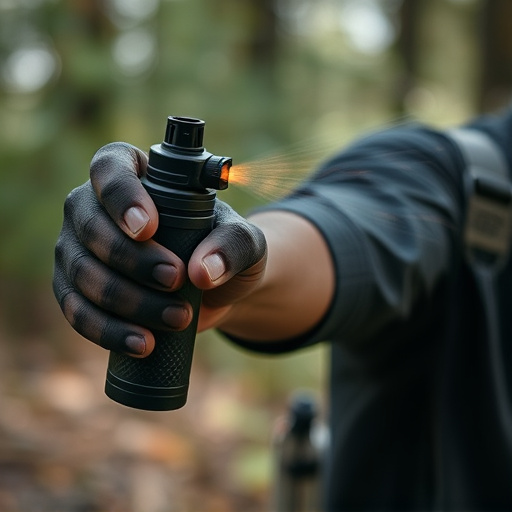Riot control pepper spray, a powerful tool in law enforcement and security, uses burning sensory disruption to manage crowds and prevent violence. Modern delivery methods, from aerosol canisters to bolt-action dispensers, offer enhanced precision and safety compared to traditional, less controlled methods. The best systems balance effectiveness, user-friendliness, and safety, with canister size, spray range, and output tailored to specific needs. These advanced technologies empower officers to handle diverse crowd control situations without endangering bystanders or themselves.
“Discover the transformative power of riot control pepper spray dispenser units, essential tools in law enforcement and security. In this comprehensive guide, we explore the role and impact of these devices, tracing their evolution from traditional to advanced delivery systems. We delve into the advantages and disadvantages of common methods, empowering you with insights on choosing the best pepper spray dispenser unit for optimal effectiveness. Uncover the game-changing features that define top-tier delivery methods.”
- Understanding Riot Control Pepper Spray: Its Role and Impact
- The Evolution of Pepper Spray Delivery Systems
- Advantages and Disadvantages of Common Delivery Methods
- Choosing the Best Pepper Spray Dispenser Unit for Law Enforcement and Security
Understanding Riot Control Pepper Spray: Its Role and Impact
Riot control pepper spray is a powerful tool designed for law enforcement and security personnel to manage large-scale disturbances and prevent violence. Its primary role is to disrupt and disperse crowds, providing crucial time for order to be restored. The spray creates a burning sensation in the eyes and respiratory system, temporarily blinding and disorienting individuals, making it an effective measure against aggressive or unruly crowds.
Among the various best pepper spray delivery methods, riot control units offer precise and controlled deployment. These dispensers are often mounted on poles or integrated into protective gear, allowing officers to direct the spray accurately towards specific targets while minimizing collateral damage. This targeted approach ensures public safety by neutralizing threats effectively without causing extensive harm, making it a vital component in crowd control strategies during high-risk situations.
The Evolution of Pepper Spray Delivery Systems
The evolution of pepper spray delivery systems has come a long way since its early days, transitioning from bulky and manual applications to advanced, compact units. In the past, law enforcement agencies and security personnel relied on traditional spray canisters, which required direct hand-to-hand contact or aiming at close ranges. These methods were not only cumbersome but also posed risks to both users and bystanders due to their lack of precision and control.
Modern pepper spray delivery systems have embraced innovative technologies, offering improved safety and effectiveness as the best pepper spray delivery methods. Today’s units often incorporate advanced nozzles and actuation mechanisms, enabling a more directed and controlled spray projection. This evolution has not only enhanced user safety but also optimized the impact of pepper spray, making it a more strategic tool in riot control and crowd management scenarios.
Advantages and Disadvantages of Common Delivery Methods
The best pepper spray delivery methods offer a balance between effectiveness, ease of use, and safety. Among common options, aerosol canisters have long been the go-to choice due to their convenience and wide coverage. These cans typically use compressed air or CO2 to expel the spray, ensuring a fast and efficient deployment. However, they face drawbacks like potential for over-dispersion in windy conditions, limited range, and environmental impact due to non-biodegradable canisters.
Alternatives include bolt-action and pump dispensers, which provide better control and accuracy. These methods require the user to activate the spray manually, offering a more deliberate approach. While they excel in targeted applications, they may not offer the same wide coverage as aerosol cans. Moreover, training is often necessary for optimal use, making them less intuitive for casual users. Nonetheless, their precision can be advantageous in tactical situations.
Choosing the Best Pepper Spray Dispenser Unit for Law Enforcement and Security
When selecting a riot control pepper spray dispenser unit for law enforcement and security applications, several key factors must be considered to ensure optimal effectiveness and safety. The best pepper spray delivery methods involve evaluating the canister size, spray range, and output—all while factoring in the specific needs of the intended users. Larger canisters provide more rounds but may not be as suitable for officers on foot; smaller, compact units are ideal for mobility but offer fewer shots. Spray range is equally critical; shorter-range sprays might suffice in controlled environments like prisons, whereas outdoor law enforcement roles demand a longer reach to subdue rioters from a safer distance.
Furthermore, understanding different spray outputs is essential. Concentrated streams are effective at close range but may require additional training to avoid accidental injuries. Mist or fog-based delivery systems offer a larger area of coverage and can be more humane by minimizing direct contact with the eyes, yet they might not stop an aggressor as swiftly. The best unit for your needs will balance these factors, ensuring officers have the right tools to maintain control in diverse situations without endangering civilians or colleagues.
Riot control pepper spray remains a vital tool for law enforcement and security professionals, with its effectiveness proven over time. The evolution of delivery systems, from traditional canisters to advanced dispenser units, has enhanced tactical capabilities and improved safety measures. By understanding the advantages and disadvantages of various delivery methods, such as handheld units, vehicle-mounted dispensers, and remote-controlled options, agencies can make informed decisions. Ultimately, choosing the best pepper spray delivery method depends on specific operational needs, ensuring maximum effectiveness during high-risk situations while minimizing risks to officers and bystanders.
